|
Comments welcome : charlie@davenportstation.org.uk |
The Altfelden pages are devoted to my unhealthy obsession with all things relating to Austrian railway branch lines of the 1990s - even unto the present day - and my little model railway 'Altfelden' which tries to recreate the happy days I have spent visiting and travelling on these lines. I hope they will be of interest, especially to my friends in the Austrian Railway Group. - Charlie Hulme,
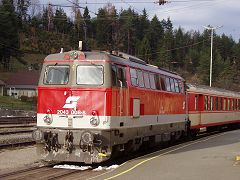
Klagenfurt - Rosenbach, 2004
2043 008 -8
Bp 50 81 29 305-0 (Jaffa)
Bp 50 81 29 017-1 (Red/Grey)
Bp 50 81 29 110-4 (Red/Grey)
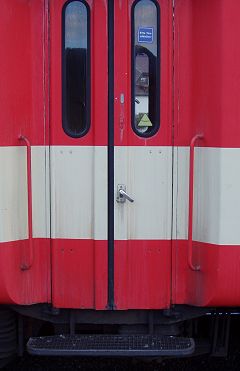
How the doors should look.
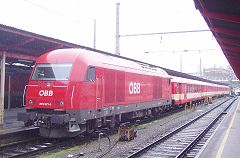
Salzburg - Braunau am Inn, 2007
2016 071-9
Bdpz 50 81 82-35 406-0 (K2/ivory)
Bp 50 81 82-35 088-2 (K2/ivory)
Bp 50 81 82-35 245-8 (K2/ivory)
Bp 50 81 82-35 088-2 (K2/ivory)
Bp 50 81 82-35 301-9 (Jaffa)
Links and references
English translation of the Wikipedia article
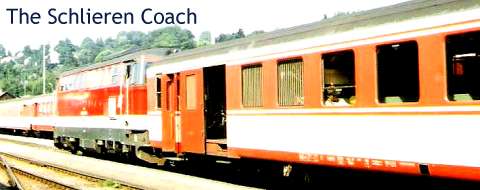
One of the Altfelden pages by Charlie Hulme
Although it seems to have been originally conceived as an inter-city coach, the OeBB's 'Schlieren' had by the 1990s become the mainstay of the loco-hauled passenger trains on Austrian branch and secondary lines, and as such is an icon for modellers of this scene. This page is a collection of information about these vehicles, real and model. As a good introduction to the subject, I have adopted and translated an article by Austrian rail expert Erich Doleschal. I hope he doesn't mind!
For more pictures, see RailfanEurope. For much more detail about these and many other ÖBB coaches, the essential book is by Peter Reinthaler and Hermann Heless, Reisezugwagen österreichischer Eisenbahnen: Vierachsige Reisezugwagen in Ganzstahlbauart der ÖBB. Düsseldorf: Alba-Verlag, 2006. ISBN 3-87094-194-4.
Contents of this page:
Overview from SVA | Liveries | Modelling | Modelling the ABp | Nostalgia fleet | Wachau consists
"Schlierenwagen" - Backbone of OeBB Passenger Traffic
Based an article in Schienenverkehr Aktuell, 1987. I have simplified the article by omitting details of variations in heating, etc. which are not relevant to modellers.
The 'Schilerenwagen' - Schlieren coaches - are, at the time of writing (1987) the most numerous coaches on the OeBB system. Their standard visual appearance gives trains a look of uniformity, but there are interesting detail differences between the vehicles in the various batches constructed over a period of 16 years.
The type gets its name from the Swiss firm of Waggonfabrik Schlieren, their design being based on that of the Swiss Federal Railways Einheitswagen Type 1 (EW 1) stock built by Schlieren. The Austrian version was built under licence by the Austrian firms of Jenbacher and SGP.
There are some obvious differences from the Swiss version, notably the nine instead of ten seating bays in second class, and seven instead of eight in first, and the 'rubber-bulge' corridor connections. The first orders were placed in 1963, and the first series of vehicles entered service in 1965.
For simplicity, the vehicle numbers in the following tables are as they stand in 1987. The first vehicles when delivered were actually classified B4ipüho and numbered 33 000 to 33 211 in the pre-computer system. From no. 212 onwards, they entered service with full UIC numbers in the form 50 81 29-35 212 ... The first four digits, 50 meaning an internal service passenger coach and 81 for the OeBB, will not be repeated here, nor will the final check digit.
Technical data for all vehicles:
Length over buffers: 23 700 mm
Length over body: 23 400 mm
Distance between bogie pivots: 17 600 mm
Bogie wheelbase: 2 700 mm
Overall wheelbase: 20 300 mm
Wheel diameter at 75mm tyre thickness: 900 mm
Minimum track curve radius: 130 m
Maximum speed: 140 km/h
Wheelset type: YRP and YRF (exchange group 64)
Axle bearings: roller bearing
Suspension: coil springs with shock absorbers
Bogie type: Schlieren
Brakes: Air, 2 x 10" cylinders. one brake shoe either side of each wheel.
The following table describes the vehicles as delivered. They have received on overhaul a second brake pipe, and also a 12-way UIC cable connector (series 37-035 and 82-35.) Other individual variations are noted in the data below.
Schlieren coaches: an overview
No. No.built Builder Years Type
29-35 000 - 259 260 SGP/JW 1965-70 B
17-35 000 - 019 20 SGP 1970 A
37-35 000 - 069 70 SGP 1968-70 AB
82-35 000 - 034 35 JW 1971-72 BD
82-35 300 - 314 15 JW 1972-73 BD
29-35 300 - 379 80 JW/SGP 1972-75 B
85-35 300 - 309 10 JW 1975 B (buffet)
29-35 400 - 439 40 JW 1977-78 B
82-35 400 - 439 40 JW 1978 BD
29-35 500 - 569 70 JW 1979-80 B
29-35 600 - 759 160 W/SGP 1980-81 B
Codes: JW Jenbacher Werke, SGP Simmering - Graz - Pauker. B second class, A first class, AB composite first/second, BD second class with luggage area.
B 29-35 000 - 259
The first group of 200 second-class vehicles, built over a six-year period and shared between the two makers, weigh 32 tons and have 72 seats, 40 in a non-smoking compartment, and 32 in what was originally a smoking section. 141 was an experimental vehicle with only 24 seats in the smoking section. Over time, many were converted to all no-smoking: as of 1987 these were 000-018 / 087-088 / 100-114 / 200 - 214 / 251 -253, with 139 / 142-146 / 215 - 223 planned for conversion by the end of that year.
Internally, they had extendible seats (the sort that will meet in the middle if the seat cushion is pulled outwards) in green imitation leather, later changed to a dark red version when the later livery was applied on overhaul. 000 to 089 were fitted with a public address system.
All were turned out in the tannengrün (fir green) plain livery standard on the OeBB at the time. a 2.5 kW 24 volt axle-powered generator was fitted, and operation into Switzerland and Italy was authorised. 043 was scrapped in 1983.
97 of these coaches were modified from 1982 onwards to provide a guard's compartment.
A 17-25 000 - 019 and AB 37-35 000 - 069
The all-first-class coaches, of which only one batch of 20 was built, corresponded to the first series of seconds, and also received the green livery. Internally, they had 'aircraft-style; seats with reclinable backrest, upholstered in a blue wool velour. 24 Non-smoking and 18 smoking seats were provided.
The 70 composite coaches, instatantly recognisable by their varying window spacing, had to have four sections: First had 12 smoking and 12 non-smoking seats, and second had 14 non-smoking and 16 smoking. Again, all initially carried the green livery.
Both types also had the axle-powered generator and were authorised for Switzerland and Italy. 17-35 007 was scrapped in 1979, and 37-35 037 in 1986. 17-35 005 was rebuilt in 1985 to a first-second composite and renumbered 36-35 000.
BD 82-35 000 - 034 and 82-35 300 - 314
These vehicles have a 40-seat no-smoking section, a compartment for the train guard, and a 20 square-metre luggage area with a carrying load of 5 tonnes. Like their matching second, first, and composite coaches, they were delivered in green, and had the extendible seats, axle generator and were authorised for Switzerland and Italy.
The guard's compartment features a window with its upper half extended outwards, to give the guard a view along the outside of the train, and a small desk and some shelves for paperwork, etc. Only a simple stool, is provided as a seat.
The second batch were identical in general appearance, but had a modification to the passenger doors, allowing them to work additionally in Germany where the original doors had been found to foul some of the higher platforms when opened.
B 29-35 300 - 379
The second series of 80 second-class vehicles, built from 1972-75, were also authorised for Switzerland, Italy and Germany. Most were delivered in the green livery, but during their period of building, the decision was taken to try a new, brighter livery. Coaches 345 - 354, built by SGP in 1975, thus featured the new Blood-orange and ivory colours, whilst 362 and 363 originally carried a blood-orange and white version.
A new type of seat appeared in these vehicles, which retained the basic layout of 40 non-smoking and 32 smoking seats. Upholstery was in a copper-red wool velour.
362 was scrapped in 1979, and 308 in 1984.
B (buffet) 85-35 300-309
These ten buffet cars were identical to the 29-35 300 batch in general detail, but with two bays of non-smoking seats replaced by a small buffet area equipped with a cooker, fridge and washing facilities. All appeared from works in blood-orange and ivory livery. This 'mini-kitchen' could be recognised from the outside by its smaller windows, with white lower halves. All had PA systems fitted and were authorised for use in Switzerland, Germany and Italy.
They all later passed to the Nostalgie fleet, and were renumbered 80 81 973 2 954 / 962-70
B 29-35 400 - 439 and B 29-35 500 - 569 and BD 82-35 400 - 439
The next series of 40 second-class cars, built 1977-78, all appeared in blood-orange and ivory and had extendible seats in the copper-red velour. The luggage racks run longitudinally above the windows. Forty of this series were modified from 1987 onwards with Webasto self-contained heaters for use with locomotives not fitted for heating supply.
They were accompanied by 40 of a new design of second class / luggage / guard's coach, with 56 seats (all non-smoking) and a much smaller luggage area of only 10 square metres. There was no change to the basic body shell, however, as the earlier BD vehicles have two bays of large windows nearest to the seating area, fitted with protective bars but otherwise matching the passenger windows.
A further batch of 70 second-class vehicles to the same design appeared in 1979-80.
These series of vehicles were not registered for Italy, only Germany and Switzerland. They were all delivered in the blood-orange and ivory livery.
B 29-35 600 - 759
The final order for 160 second-class cars, like the very first was shared between JW and SGP, and all appeared in blood-orange and ivory and were authorised for Germany and Switzerland only. Internally, they differ from previous second-class batches in that a new, more modern, type of seat was used, similar to (bit narrower than) the 'aircraft' seats used in the early first-class versions, having a reclinable back but not the 'extendible' feature. The copper-red velour uphostery style was retained. The luggage racks run longitudinally above the windows.
705 was withdrawn in 1984.
The Schileren interior
When first introduced, the Schileren coaches' internal design was of the most modern design. The green imitation leather ('Skai') upholstery and the extendible 'Bremsheysitze' or or 'lying-down seats' were very popular with the travelling public. The transverse luggage racks above the seat backs are very practical, as are the coat-hooks provided by each seat. The interior cladding of the coach sides is in a light maple.
The decor of the first class cars remained unaltered in 1987. The dark blue adjustable aircraft-style seats, longitudinal luggage racks, carpets and dark pear wood walls give a sense of timeless elegance.
With the introduction of the new livery and the change of upholstery to copper-red, it was decided that the 'luggage forest' appearance created by the transverse luggage racks was out of style, and from the 29-35 400 series of 1977, longitudinal racks were fitted to the second class, although the seats themselves were not changed. This caused problem in bad weather, as all the coat hooks were now on the coach side, with the result that coats hung up by the aisle-side passengers got in the way of window-side passengers. This problem was solved in the final series by changing with the final 29-35 600 series to individual 'airline' style seats which have a space between the seat-backs where coats can hang on the wall-mounted hooks.
The floor covering was originally a red-brown material, changed to black when the new livery was adopted. Other slight changes were made to the second class interior decor: the green imitation leather was replaced by red in the new livery, and the white cloth headrests were replaced by imitation leather on overhaul from 1980 onwards to reduce the costs of cleaning them.
Notes by myself:

Schlieren coach liveries 1965 - 2007
In 1965, the standard coach livery was 'fir green', with black undergear and a roof painted aluminium to reflect the sun, and at first the Schlierens followed this pattern. In 1975, along came the new blood-orange and ivory look, and new vehicles appeared in these colours. The green ones were repainted fairly quickly, and seem to have been a fairly rare sight by the 1980s; the last one (23-35 195) was repainted in the new colours in May 1983. More recently, a number of vehicles, including the surviving buffet and first-class coaches, have returned to green as part of the OeBB's nostalgic fleet.
It seems that when the first-class coaches were first re-painted, they had a variation in the livery, featuring a cream band at the bottom of the sides below a red line: a picture in Georg Wagner's 'OeBB Heute' book shows three of them at the front of an Innsbruck - Vienna train in the early 80s. The layout was equivalent to that of the class 4010 inter-city electric railcars, with the blue replaced by orange.
From 1977, new Schlierens were delivered in the new livery, although it appears that early examples had a lighter cream known as cream-white rather than ivory, but this showed the dirt very badly, especially on the skirt. The skirts were soon repainted blood-orange and given white lettering.
The people who designed the new livery thought it would look really good if the whole roof was painted cream as well as the lower part of the sides, and many vehicles appeared like this. What they seem to have forgotten would be that it would be difficult to keep these roofs clean, especially on lines with diesel traction and tunnels. In 1983 29-35 423 was, as a trial, given a dark grey (umbraugrau) roof, above the line reachable by the brushes of the washing plants. Before long that scheme, with just a cream strip above the windows, was widely adopted, and by the late 1990s cream roofs were rare, and if still cream were well-covered by dirt.

In 1986 a new, simplified livery (known as 'Sparlack' or 'K2') for the Schlierens appeared, without the narrow lining bands of the previous version, and with the upper ivory band extending higher on the roof, and the blood-orange skirt reaching higher up the side, as shown above. The roof retained the dark grey colour. On repaints after 1990, the layout remained the same but the blood orange was changed to 'traffic red' - verkehrsrot: quite a subtle change, especially when looking a photographs. However, a good proportion of the fleet never carried this scheme, retaining the old 'lined' version. Certainly in 2007, many trains on the more rural lines offered a mixture of the two types. In the late 1990s, a further change to specifications required the ivory to be replaced by light grey (hellgrau) - as found on the Class 2043 locos - this is rare on Schlieren coaches, although the ivory on some vehicles appears to have faded to a rather grey shade.
Another livery variation involves the bogies, which were changed from black to dark grey at around the time the traffic red appeared.
Latterly, some examples gained a blue and cream livery for use on the 'Radtramper Donah' Wien - Passau cyclists' train. The takeover of the Wachau route by NÖVOG and its partial re-opening in 2011 led to a hideous 'graffiti' livery applied to three coaches (29-35 077, 29-35 344 and 82-35 314) and a 2043 loco, thankfully replaced in 2012 by a gold and grey scheme in common with other NÖVOG lines.

Modelling the Schlierens
H0 Scale
H0 scale modellers are fortunate indeed in that Roco produce marvellous models of the type, to scale length and with excellent livery and details, perhaps let down a little by the rather crude handrails by the doors.
Roco have produced the first class, second class (Bp) and second/luggage (BDp) variants, and over the years more or less every livery variation has appeared. There are two types of door handrails, one reasonably thin version, in black plastic, and one in a thicker material which is in the correct orange. Neither are entirely satisfactory, with their unrealistic sockets on the carriage side, but replacing them neatly with hand-made wire ones has so far defeated my modelling skills. There are also two types of bogies in circulation, one with holes into which fit the steps for the doorways, and a locating log for the axles-driven generator, and one without. Bogies come moulded in black or the later grey.
They lend themselves well to detailing of the interior, fitting of lights, and so on, and are really all you need - apparently even the first class ones have appeared on local trains on occasion. The ideal train for your branch line is a BDp and one or two Bp.
Sadly, these models are not always listed in the Roco range, but can be found on the second-hand market. Beware of missing parts, though.
The Kleinbahn company has also modelled the type, but these are very much underscale and best avoided.

Known vehicle numbers of Roco models (contributions welcome)
| Type |
Roco
serial
number |
50
81 ... |
Livery |
Roof |
| Apo | |
1735 014-2 | green |
|
| Bpo | 29-35 123-7 |
green |
||
| Bpo |
29-35 215-1 | green |
||
| BDpo | 82-35 001-9 | green |
||
| Bpo |
29-35 255-7 |
early orange |
Ivory |
|
| Bp |
29-35 224-3 |
early orange |
Ivory |
|
| Bp |
29-35 024-7 |
early orange |
Grey |
|
| Bp |
45125 |
29-35 |
early orange |
Grey |
| Bp |
44491 |
traffic red /
grey |
Grey |
|
| BDp |
82-35 034-0 |
early orange |
Grey |
|
| BDp |
82-35 020-9 | traffic red /
Ivory |
Grey |
|
| BDp |
45126 |
82-35 |
early orange |
Grey |
| BDp |
44490 |
traffic red
/grey |
||
| Ap |
45124 |
17-35 012-4 |
early orange |
Grey |
| Ap |
45122 |
Green |
Aluminium |
|
| ABp (Buffet?) |
45129 |
early orange |
Grey |
From the Roco 2003 catalogue:

Roco 45124

Roco 45125

Roco 45126
N Scale
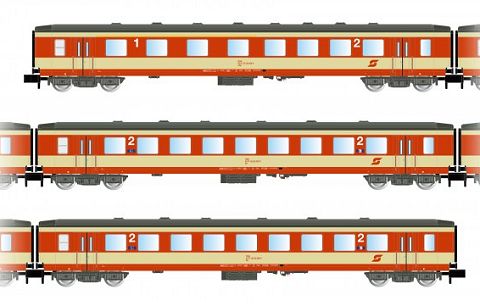
For N scale, since this article was originally compiled Arnold have released a range of models, featuring all four body versions including the first/second composite which is not available as an H0 model; several of these were converted to cycle-carrying duty and would look good in a branch-line train with the large figure '1' deleted. The coaches are initially only available as two alternative sets sets of three, neither of which is ideal for ordinary branch line use, as you can't get a brake-second without also getting one of the rarely-seen first-class ones.
Modelling the ABp - by Norman Lamb

Roco never made the 1st/2nd class composite version, but I have a 'cut & paste' ABpo which I made from two Roco H0 coaches. I have done my best to make the AB version by cutting an A and a B and sticking the relevant halves together to make 2 x AB. OK, it isn't a perfect result but it kept me happy for a while. The cut was down one side of a window - this kept blade damage to a minimum.
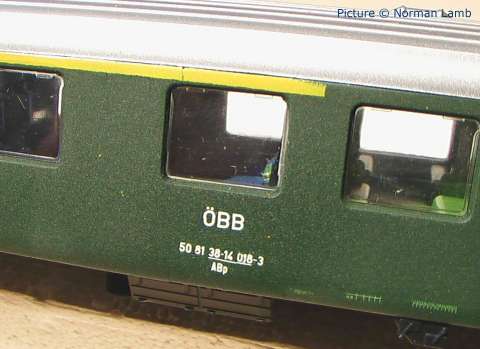
The cuts were at the 1st end of the 4th Apo window and the 1st end of the 5th Bpo window. I did make two, but the other one was sold - I can only assume this one joined the 2nd end of the 4th Apo window to the 2nd end of the 4th Bpo window.
The 1994 Nostalgia Fleet
translated from Eisenbahn Ilustrierte May 1995.
The "OBB-Schlieren" coach design was a modification of the Einheitswagen 1 (EW 1) type built from 1956 - 1967 by Schlieren of Switzerland for the SBB. From 1965 to 1981 a total of 800 domestic-service coaches were built in Austria under licence for the OeBB. The differences from the SBB cars included rubber corridor connections, allowance for the central buffer coupling, interior lighting, more comfortable seating layout and the cheaper resistance heating.
As delivered there were first-class cars (Ap 17-35 000 ... 019, 2nd class cars (Bp 29-35 000...569 / 600 ... 759), Composites (ABp 37-35 000 .. 069), second / luggage (BDp 82-35 400 ... 439) and 2nd Class with buffet compartment (Bp 85-35 300 ... 309). The Ap 17-35 and ABp 37-35 batches, and the first ABp and BDp were delivered from the factory in "Tannengrun" green livery. The new "Jaffa" scheme was established in 1975, initially because the first class cars were used as substitute InterCity trains, due to a shortage of lack of complete sets of the Class 4010 railcars.
By 1994 the first-class vehicles (ABp 17-35) were no longer needed in timetabled operation, and the first seven cars have been transferred to the nostalgia fleet, along with a buffet car of the Type 85-35 300. These eight cars are being repainted at St. Polten works to their original green livery. The first two cars were first used on Dec 24, 1994 in the Vienna-based "Crocodile to Christmas" tour and the New Year's Eve special to Puchberg am Schneeberg and were very popular with the travelling public.
| Type |
Old number |
New Number |
| Ap |
50 81 17-35
001-9 |
80 81 97-32
955-6 |
| Ap | 50 81 17-35
008-4 |
80 81 973 2 956-4 |
| Ap | 50 81 17-35
013-4 |
80 81 973 2 957-2 |
| Ap | 50 81 17-35 016-7 | 80 81 973 2 958-0 |
| Ap | 50 81 17-35 017-5 | 80 81 973 2 959-8 |
| Ap | 50 81 17-35 006-8 | 80 81 973 2 951-5 |
| Ap | 50 81 17-35 010-3 | 80 81 973 2 952-3 |
| Ap | 50 81 17-35
019-1 |
80 81 973 2 953-1 |
| Bp / Buffet |
50 81 85-35 309-3 | 80 81 973 2 954-9 |
Note: a number of other vehicles were transferred to what is now called the 'ErlebnisBahn' fleet after this article was written in 1994, and re-numbered in the same series. Of the 20 Ap vehicles built, 18 had been converted by 1995; 35 007 had been scrapped after an accident in 1979, and 35 002 was withdrawn in 1996. All ten of the buffet cars, 35 300 - 309, were also transferred, as were a small number of second-class cars.
Unfortunately, the Erlebnisbahn organsation was closed down in 2014, following allegations of financial irregularity, and much of the Nostalgia fleet has been dispersed.
Schlierens in the Wachau 2009
The stock and formations of the Erlebniszug Wachau, September 2009, the occasion of my last few rides in Schlieren coaches.
24.09.2009. Loco 2016 065-1 at Spitz an der Donau awaiting return to Linz.
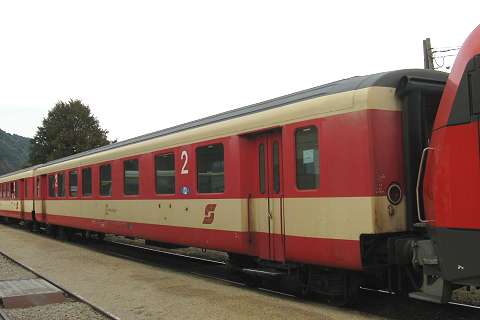
BDp-L 2nd/bike carrier 58 81 84-33 005-0 (converted from ABp)
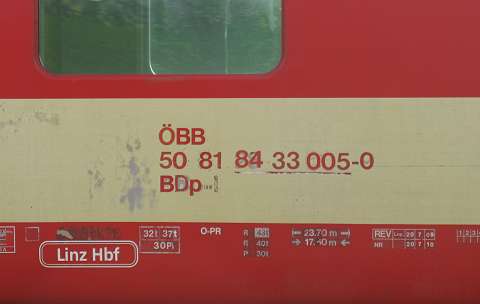
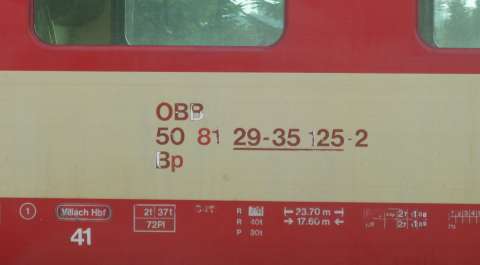
Bp 50 81 29-35 125-2
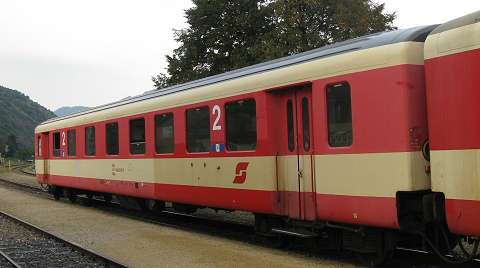
BDp-L 2nd/bike carrier 58 81 84-33 001-9 (converted from ABp)
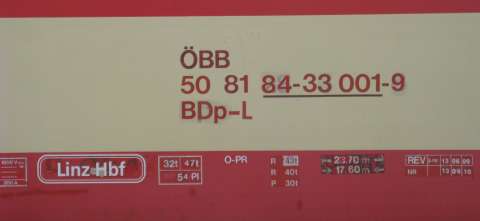
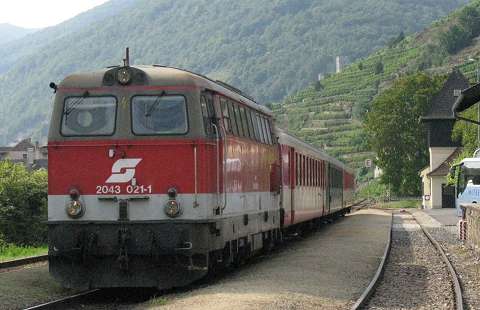
27.09.2009. Loco 2043 021-1.
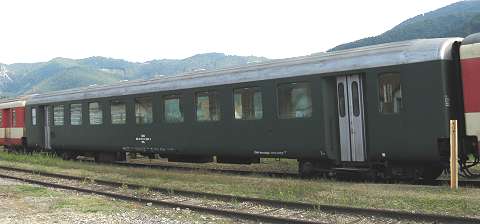
Weekend Consist: Bp 50 81 29-35 125-2, ErlebnisBahn buffet car BRz 80 81 973 2 966-3, BDp-L 58 81 84-33 005-0.
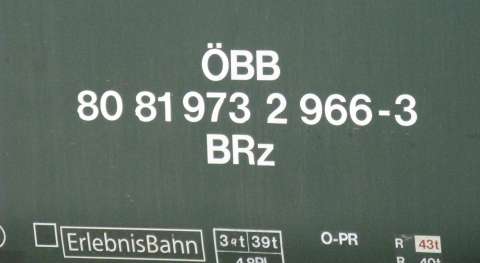
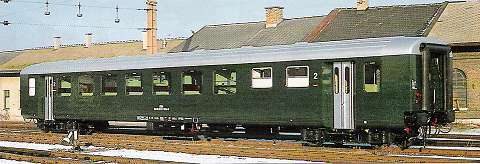
This buffet car was formerly 50 81 85-35 307-7; it features the two higher windows on one side as in the picture above, and would be a simple and interesting conversion project from a second-class vehicle. All ten of this batch found their way to the ErlebnisBahn fleet, and from there moved on to various heritage operations; three of them to the Hungarian MAV Nostalgie fleet. 966-3 went to Austrian Railway History Society OGEG based at Ampflwang.
Postscript
Of the main fleet, by 2016 many had been withdrawn from service, replaced by the later so-called 'long schlierens' passed dowen from inter-city service, or replaced on branch lines (those that have not closed) by class 5047 railcars, leading to peak-time overcrowding in some cases. A number have been sold on to other operators, in Austria and elsewhere; in 2009-11 10 vehicles from the later-built batches found their way to Kosovo. The GySEV (Raaberbahn) has several now in its striking green and yellow livery.
Some good news is that the Verein der Eisenbahnfreunde in Lienz (Lienz Railway Club) has dedicated itself to preserving and restoring some of these fine vehicles for use on special trains on the main line:
Buffet car BRpz 50 81 85-35 306-9
Ap 80 81 97-32 958-0 (ex 50 81 17-35 016-7)
Bp 50 81 29-35 139-3
BDpoz 50 81 82-35 429-2
Another coach, 50 81 29-35 417-3 was obtained, but proved too corroded in the underframe area to be restored.
The aim is to represent an OBB train of the 1975 period, and as such the three-car train has been given the first version of the 'Jaffa' livery with ivory lower section. Three cars have been in traffic in traffic on special trains in summer 2016, hauled by 'Crocodile' loco 1020.018, which is also in the care of the Club.
Happy days
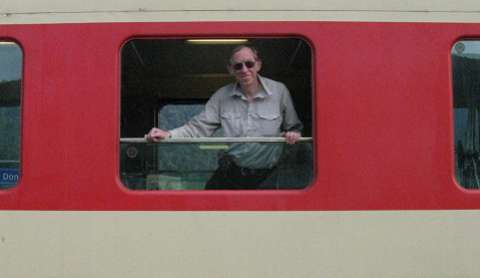
Charlie demonstrates the later style of window with metal bar and handle. Early vehicles had two hand-grips fixed to the glass and no top strip.
Last update September 2016.
